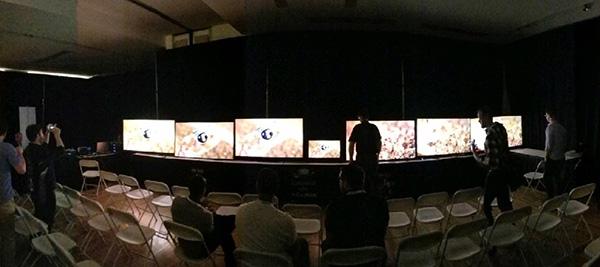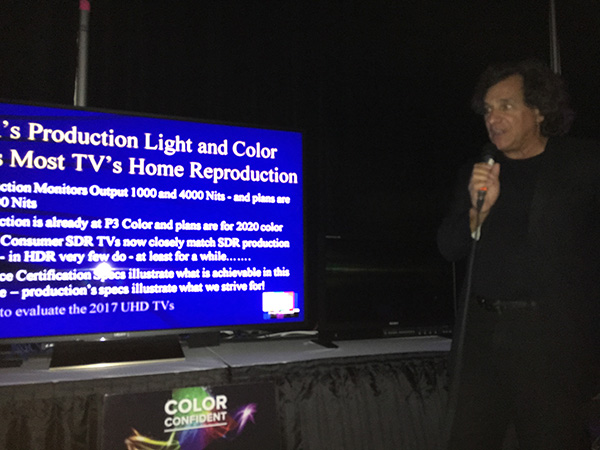LG OLED Sweeps 2017 TV Shootout

In what appears to be an ongoing trend, LG took top honors Thursday at this year's TV Shootout at CE Week in New York. This marks the 4th consecutive year that LG's current top OLED model, this time the 65-inch E7, was declared the annual "King of TV" — a title even more deserving than in year's past thanks to the set sweeping all three of the judging categories.
But despite what by now seems like a familiar or expected result, this year's event was more competitive and interesting than in recent years, with at least one set that very nearly equaled the LG, and others that failed to come as close as we'd have expected.
Scarsdale, NY retailer Value Electronics started the event more than a dozen years ago, but it was run this year for the first time by a joint partnership between CE Week management and the Imaging Science Foundation's Joel Silver. Value Electronics retains the "TV Shootout" trademark, company founder Robert Zohn told guests, but licensed it this year. ISF's Joel Silver explained that prior Shootouts were conducted amidst criticism that, as a retailer, Value Electronics had a vested interest in seeing an outcome that favored brands represented on its floor, and that the company's selection of samples for the event from its own inventory cast doubt on the results. The new arrangement addressed those concerns by placing organization and execution of the event in Silver's hands, who acted as presenter along with respected ISFTV calibrator Kevin Miller; Spectracal's Tyler Pruitt and AV Pro's Matt Murray also assisted with calibration and handling the wiring and switching of test signals to the high-bandwidth 4K distribution amp that simultaneously fed all the TVs. CE Week management was said to have purchased most of the TV's at retail, the exception being a Sony Z9D LCD model that is currently backordered in stores. In that one case, Sony helped facilitate a loaner for the event.
Shootout participants were all at the 65-inch screen size and included the LG E7 mentioned earlier (currently about $4,800 retail), the Sony AE1 OLED (which uses an LG OLED panel but with Sony's proprietary processing, $5,000), and LCD displays that included the Sony Z9D (with the company's unusual full-array high-density LED backlight, about $5,500), Samsung's current Q9 flagship ($4,000), the top Vizio P Series (the new 2017 model, which features last year's chassis with updated firmware to improve image quality, $1,700), and the Westinghouse WA65UFA1001 ($650). The latter set is a new budget model featuring an Alexa-driven Amazon FireTV interface, but given that there was no judging of the sets on the user experience beyond image quality, it clearly had no business being in an event populated by today's state-of-the-art displays and its odd appearance seemed to be an ultimately embarrassing nod by CE Week management to Westinghouse, which, along with Samsung, was one of just two TV brands who bought exhibit space at the mini trade-show taking place just outside the event room. So much for the appearance of impartiality. The set's obviously poor contrast and black level relative to its competition, along with other image failings, eliminated it quickly.

Along with taking over management, Silver and team added credibility to the judging process this year by replacing the traditional consumer/spectator balloting with a team of four expert judges who all work in some capacity in the video production and display arena, either setting up displays for post-production or film industry creatives, or installing equipment in support of those displays; the prime qualification, Silver said, was that they spend their days looking at or tuning pictures used in the generation of content. Additionally, as noted earlier, the competition was split into three "best TV" categories this year: Studio Lighting/Home Theater (essentially dark- or dim-room viewing with calibration optimized for these conditions); HDR/Bright Room Performance; and Streaming Performance. That last category is a powerful recognition of broad lifestyle changes that have resulted in so much content now being viewed via the Internet. To help facilitate the judging of each set's internal streaming platform, Murray uploaded 4K test patterns to YouTube to allow judges and spectators to see to what extent detail is diminished by the upload/download process compared to the same pattern from a generator. (Answer: considerably diminished, though not unwatchable. Still, I won't be giving up my disc player anytime soon. )
For the Studio Lighting/Home Theater arena, the judging of most interest to serious enthusiasts, the criteria included Perceived Contrast Ratio (which counted for 40% of the total score), Color Saturation and Color Volume (20%), Colorimitry including Grayscale Tracking, Gamut Coverage, and Saturation (20%), and Motion Artifacts/Perceived Lag (20%). Ultimately, the LG E7 swept all three of the main judging categories including Studio Lighting/Home Theater, though the score was so close between the LG and Sony OLEDs in this category that the judges felt compelled to give the Sony an honorable mention. Not surprisingly, the Sony Z9D produced brighter HDR highlights than any other set but couldn't quite deliver blacks with the perfect uniformity and lack of haloing demonstrated by the emissive OLED displays. Samsung, normally a stronger contender against the LG OLED with its top line sets in previous years, was also done in by the dark blacks and precision dark-screen uniformity of the OLED models; the Q9 features an edge-lit backlight this year instead of a full-array local dimmer, and ultimately showed its limitations. If there was a pleasant surprise at the shootout, it was the somewhat overshadowed Vizio P series, a full-array local-dimming model that, while outclassed by the OLEDs and Sony Z9D at the other end of the room, held up pretty well against the $4,000 Samsung sitting alongside it—at more than twice its price. Had there been a "best value" category, this likely would have been the recipient.
In the end, though, the LG E7 was an obviously stunning display in virtually every way and deserving of its accolades. It wasn't quite the equal of the $30,000 Sony OLED studio monitor included as a reference in either black performance, overall detail, or general punch and depth of the image, but at more than twice the 30-inch monitor's diagonal screen size, the LG came awfully close. And with the Sony OLED not far behind, it's clear that 2017 is the year of the OLED. Hopefully, other brands will jump in the OLED fray and give us more to cheer about at next year's shootout.



















































